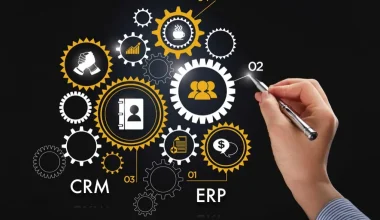These are intriguing times, and with them come better prospects. Digital change and the introduction of new technological trends have been hastened by the prevalence of the Internet as a platform. In light of these shifts and the necessity of staying current and competitive, it is crucial for businesses to have a system in place that links IT with the rest of the company’s operations and strengthens the bond between the two. This is the main purpose served by BRM (Business Relationship Management) as a capability, role, or function. In the business world, Business relationship management isn’t revolutionary. There has been an official nomenclature for this function for the past decade, but its many parts have been known by other names for at least that long. In this article, we will discuss Business relationship management strategies for small businesses.
What is Business Relationship Management?
The term “business relationship management” (BRM) refers to a set of values, skills, and responsibilities for improving organizational outcomes like culture, relationships, value creation, and mission fulfillment. The business relationship manager (BRM) function is the skill set needed to boost the organization’s BRM capacity. Business relationship managers are those who take on the responsibilities of BRMs and possess the skills necessary to develop this competency.
Furthermore, by attempting to capture, assess, and communicate the potential business value of the products and services, BRM does more than only rationalize and shape business demand for the products and services. The role of the Business Relationship Manager (BRM) requires an understanding of both the business and the technology landscape, as well as the ability to ask the right questions, spot areas where IT can provide strategic value to the business, and collaborate with other departments to put those plans into action. The role of business relationship management is to change the focus of the organization from “doing the job” to “achieving the results.”
What Are the 5 Stages of Business Relationship Management?
Here are the 5 stages of business relationship management.
#1. Service Strategy
The Service Strategy book is where you will mostly find definitions for Business Relationship Management. Consequently, it is intrinsically designed to engage with its processes.
- Service Portfolio Management. It’s not your first option when thinking about how to manage services. If your BRM is dedicated to his role, they will invest considerable time in this phase of the process, regardless of its development stage. What options do we have for serving the client? Do any fresh options exist? What is the connection to the various services we offer our clients? Should we develop brand-new offerings or adapt our current methods to meet the standards? Things of that nature.
- Demand Management. Relatedly, Business Relationship Management will leap at the chance to lend its support to either the current or proposed business processes.
- Financial Management for IT Services. It is another critical but frequently overlooked facet of managing IT services. Cost and price models will need to be maintained by your Business Relationship Management to facilitate reporting and, more crucially, the assessment of potential returns on investments in novel business ventures.
#2. Service Design
The strategy phase is inextricably intertwined with Service Design. As a result, it’s important to take care of a few procedures. It’s mainly about the old ways of doing things in Service Delivery:
- Service Level Management (SLM). Since the BRM’s primary responsibilities will fall within the realm of account management and Service Level Management, they will play an integral role in this procedure. When a consumer calls, what kind of service do they get? Is it congruent with what matters most to the clientele? Is the client well-versed in the measures and KPIs? What is the relevance to needs associated with the updated or new services?
- Availability, Capacity, and IT Service Continuity Management. We know that these procedures have close ties to the SLM procedure that came before them. The business relationship management will keep an eye on things like service availability, communication failures, resource availability, and capacity to ensure that everything is running smoothly and in accordance with business continuity standards.
#3. Service Transition
The BRM will keep a tight eye on everything that happens with the services he provides to his clientele. Their primary focus will be on making ensuring that upgrades are implemented methodically so that service quality is not degraded or downtime is minimized.
- Change management. It is the BRM’s responsibility to suggest and advocate for changes that will enhance IT’s ability to serve the business. That’s why the Business Relationship Management (BRM) is the one that typically submits RFCs on the customer’s behalf and attends CAB (Change Advisory Board) meetings as their advocate. In smaller businesses, business relationship management is the perfect opportunity to test out any new services that may be implemented.
#4. Service Operation
It would appear that Business Relationship Management is not as involved during the Operation phase. Business Relationship Management should invest significant time in this area, particularly during Incident Management.
Furthermore, the BRM is responsible for handling user feedback in the form of complaints, post-incident surveys, and compliments after major modifications and initiatives have been deployed (early life support). Also, the BRM can play a crucial role in keeping the customer abreast of developments in the resolution of Major events. Here, defining the Major incident protocol in a way that BRM genuinely aids the team rather than meddling, getting in the way, and clogging the communication lines unnecessarily is of utmost importance. This is how BRMs usually act in the real world.
As an entry point into the Problem Management process, the BRM will monitor incident trends in order to identify any recurring or interconnected incidents. In my opinion, the ITIL Service Strategy book has to devote more space to the topic of BR Management and Problem management integration if they are serious about improving customer happiness.
#5. Continual Service Improvement
The purpose of the Business Relationship Management process is to enhance the service and its contribution to the company. The BRM keeps an eye on feedback from the first four stages of the customer’s journey, such as surveys, complaints, praises, and requests. Using this data, we can spot emerging possibilities and move them along in the lifecycle model, from Strategy to Operation. Although this cycle relies heavily on the characteristics and abilities of the BRM, most established providers of services use the Seven Steps to Improve Service Delivery to enhance it.
Most IT service providers would be overstaffed if they assigned a Business Relationship Manager to each of their customers. However, even if the provider is not yet mature enough to adopt a full Business Relationship Management process, the account managers on both the technical and sales sides of the business can benefit from the best practices outlined in this ITIL procedure.
How Business Relationship Management Works
A company’s success depends on its ability to attract and retain both business partners and customers. Business Relationship management is used to accomplish this. Customer loyalty and satisfaction can be improved through relationship management tactics that work to strengthen patronage of a company’s products and services. Relationship building is most common at the customer level but also has value among companies.
Benefits accrue to both parties in a mutually beneficial relationship with customers. If a business shows that it cares about what its customers want, those customers are more inclined to stick with it. The same holds true for partnerships between companies. Simply put, a stronger bond between business partners increases the likelihood that they will remain dedicated to one another.
New businesses can often be attracted by a company’s well-known responsiveness and high level of post-sale involvement. Also, keeping in touch with customers allows businesses to foresee and prevent costly issues.
Furthermore, a company can assign a specific person the task of managing relationships, or they can include this responsibility in an existing marketing or human resources (HR) position. As a business relationship manager, you’ll need to think critically and communicate effectively. In a smaller company, one person may be responsible for both customer service and business development. In larger organizations, there may even be two people working on each of these tasks.
Customer Relationship Management for Small Businesses
For small businesses, customer relationship management software that consolidates client information is important.
Small businesses that have yet to adopt customer relationship management (CRM) will have a golden opportunity to do so in 2023. You might think there’s no need to spend money on customer relationship management if your company is just getting started. After all, resources are limited, and you would rather not waste money on unnecessary fixes. This is where the vast majority of startups fail. In the past, you might not have needed a customer relationship management system to help your firm succeed. However, times have shifted, and creating meaningful connections with customers is now more vital than ever. Therefore, a system to aid in their management is required. In addition, startups that care about their future should pay special attention to this.
Is a CRM Useful for Small Businesses?
Simply yes.
Companies of all sizes should make customer satisfaction their top priority because studies show that 76% of customers will stop using a firm after just one unpleasant encounter. A customer relationship management system can make or break a company’s success in this field.
However, in order for a CRM to maximize productivity for your company, it must be utilized properly. A customer relationship management system (CRM) for a small business serves as a hub for all of your client information and communications, although other companies may just see it as a lead management and generation or sales tool.
In fact, sales tracking is only one function that a top-tier CRM ought to provide. Your sales team needs to be in constant communication with your marketing and customer service departments. Monday Sales CRM allows you to customize your own sales pipeline management software that integrates easily with other platforms so you can keep track of everything.
Top Best CRMs for Small Businesses
It might be challenging for a small firm to choose the finest customer relationship management system (CRM) from among the many options available. The best customer relationship management (CRM) tools for small enterprises are discussed in greater depth below.
#1. Zoho CRM
The Zoho CRM software helps its users improve lead generation, sales velocity, and performance measurement. Zia, the artificial intelligence-powered built-in assistant, aids in forecasting leads and deals, identifying prospective customers, and directing the efforts of huge sales teams. Zoho’s “trophy” features encourage healthy competition while maintaining a positive work environment, making it a great choice for distributed teams.
Pros:
- Accessible at no cost
- Hold meetings and give talks without leaving the CRM.
- Send notifications to distant employees.
Cons:
- Enterprise subscribers pay more for access to the AI-powered assistant.
- There is an additional fee for after-hours customer service.
- Limits are placed on the use of some functions per day.
#2. Freshsales
It’s easy to improve your interactions with customers with the many features available in the Freshsales CRM software. There’s also an AI assistant built-in, named Freddy, who can analyze past sales data, user activity, and user engagement to help businesses better understand their clientele. In addition, Freshworks has a VoIP phone service integrated into the platform, with toll-free local numbers available for purchase in over 90 countries and calls made from any device.
Pros:
- Standard Voice over IP phone service
- Free for a full 21 days!
- Discounts for all-time
Cons:
- Extensive premium pricing tiers for added functionality.
- Limits on file storage
- In-built VoIP does not support cloud-based call management features.
#3. Pipedrive
Pipedrive is a customer relationship management system designed for small enterprises with a focus on visualizing the sales process. It has a drag-and-drop interface for speedily completing critical activities, as well as editable pipelines and fields for standardizing and streamlining operational procedures. In addition, its mobile app makes it easy to communicate with clients and employees from any location.
Pros:
- Apps for mobile customer relationship management that are useful
- Constant email and chat availability
- Intuitive, easy-to-navigate UI
Cons:
- Doesn’t have a built-in email system
- For the cost, there is a lack of features.
- There is no cost-free option
Relationship Management Strategies
Management of interactions with current and potential consumers is a part of customer relationship management. However, maintaining strong connections with customers is crucial to a company’s long-term health. Providing satisfying service to customers is essential to establishing and maintaining positive relationships with them. Maintaining a strong connection with your clientele is essential.
Furthermore, the success of a company can be measured by how quickly it expands, how many new consumers it attracts, and how positively it is viewed by its existing clientele. Here are some top relationship management strategies.
#1. Make Customer Service Robotic
Rapid responses are much appreciated by patrons. As a result, most customers will become unhappy with a slow response time and look elsewhere for service. Therefore, executives have automated their support systems to provide a prompt response. A reference number, a link to frequently asked questions or a knowledge base, and hours of operation for customer service are all useful additions to an automated response. The greatest chatbots can automate customer service, leading to a quicker response time, higher engagement, and greater consumer interest. To better serve your customers, you should familiarize yourself with the function of chatbots and the value of automated customer assistance. With automation, not only can you respond rapidly to all customer inquiries, but you can also save time doing so.
Chatbots are crucial because they enable businesses to provide precise replies to customers, which in turn reduces the number of support tickets filed by customers. The best way for a chatbot to serve a company’s clients in the future is to be fed common questions and pre-programmed responses. In the event that a company’s support staff is busy or otherwise occupied, a chatbot can continue to interact with clients around the clock.
#2. Consistent Interaction With Clients
Without client involvement, a company is likely to collapse. Top-level management actively involves customers and solicits feedback to prevent catastrophic failure. Active and valued customers are happy customers. A fun way to engage customers is to solicit feedback on the current selection and any additional features they might want to see. The best managers always follow up with a thank-you note to their clients. Customers are ecstatic about this since they know they are making a difference to the company. Also, read Relationship Management: Definition, Examples & Strategies
When new products are introduced, the highest-ranking executives inform customers via email and other channels of communication. Products are suggested to customers based on their previous purchases. In addition, they ask existing buyers to spread the word about their products and reward them for doing so. Customer loyalty programs are another tool used by top executives to keep customers coming back for more.
Successful business leaders leverage social media to expand their customer base and foster deeper connections with their existing clientele. However, they guarantee constant content production in order to completely connect with their audience and hit all the necessary touchpoints. They may learn from their customers and strengthen their weak points by publishing content regularly and soliciting feedback.
Customers that take an active role in the process are more likely to feel like they matter. It’s always ideal for customers to voluntarily engage with a company. Customers who are interested in a company’s products and services are more likely to buy from that firm if the company has a strong brand voice and produces high-quality content. When the material is interesting, it encourages communication between the company and its audience. In addition, executives that frequently interact with their clientele enjoy higher levels of credibility, brand trust, and reputation.
#3. Maximize the Happiness of Your Customers
If a customer is satisfied with the services they receive, they will most likely return and tell their friends about the company. The best managers continue to meet and often exceed, their consumers’ expectations. Customers who are delighted with the service they receive are more likely to return. When designing products and services, top executives take client feedback into account. Taking into account consumer feedback helps businesses gain a deeper familiarity with their clientele.
They pay close attention to the needs of their clients and work tirelessly to meet or exceed those needs. A happy customer is a result of a positive encounter. In addition, they work to reduce customer issues and enhance the quality of customer service. This raises the lifetime value of a consumer and ensures their satisfaction and loyalty.
In addition, fewer unsatisfied consumers mean less potential for damaging online reviews to drive away business. Continuously assessing client happiness and monitoring changes is the only way to eradicate this. In a cutthroat market where companies battle for consumers and income, a company’s ability to keep its customers happy can be a differentiating factor.
#4. Implementing Social Media
The usage of social media in customer service is on the rise. Top-level executives rely on client input, both favorable and negative, obtained through social media. The beautiful thing about social media is that it allows for interaction, which means that companies and customers can talk to one another and share their thoughts. The best managers listen to their clients and guarantee satisfaction by making necessary changes. Also, businesses frequently interact with their target audiences via social media sites like Facebook, Twitter, Instagram, and LinkedIn. Interactions fostered by social media help keep and grow clientele.
Furthermore, managers can use social networks to show their clients how much they are appreciated. Solution-proposing and group decision-making are both facilitated by these channels. Online evaluations are extremely important for organizations, thus it’s important to respond to postings and social reviews as soon as possible. Your business can benefit from both more and better reviews posted online because a higher SEO ranking means more visitors. When interacting with customers one-on-one, it’s important to add a personal touch. During contests and promotions, giving customers tokens can help you build lasting ties with them.
Customers can easily spread the word about your business via social media. As a result, they provide excellent openings for top-level management to establish strong bonds with their clientele. Such connections boost client happiness and confidence in your company.
Why Do Companies Use Business Relationship Management?
Many successful business owners and executives struggle with the temptation to control every facet of their company. Many private organizations’ small and medium-sized business owners may be the ones tasked with putting out fires within their organization. They have the opinion or conviction that nobody else in their organization can help them fix the issues they’re facing. This is often the case, however, it is usually the case simply because of how the structure was designed. There needs to be a shift in this direction should the company’s leader become a hindrance to growth. If you want to take your company to the next level, you need to implement certain changes to improve your processes and procedures. Here are some of the top reasons companies use business relationship management.
- Cooperation
- Enhancing Capacity for BRM
- Recruit Experts in Many Fields
- Customer relations prevent customer churn.
- Distinguishing Features of Your Customer Service
Conclusion
Having a solid offering doesn’t guarantee prosperity on its own. These might bring in some new clients and vendors, but will they stay? Business Relationship management strategies are crucial to the success of businesses. To promote brand loyalty, profits, and efficiency, and decrease risk, as well as to entice and keep new consumers and suppliers, this tactic is employed. Some businesses employ a specialist known as a relationship manager, while others prefer to use software or other automated methods.
Business Relationship Management FAQs
What Is an Example of Business Relationship Management?
In the banking and finance industries, for instance, the Business Relationship Manager is responsible for both maintaining and expanding existing clientele. Also, in the banking industry, BRMs are often tasked with managing a portfolio of SMBs.
What Is the Main Purpose of Business Relationship Management?
In order to thrive, businesses need to build and keep solid customer and partner connections. Relationship management is used to accomplish this. Customer loyalty and advocacy for a company’s products and services are two of the primary goals of relationship management.
Similar Articles
- Best 15 Compensation Management Software In 2023
- What is Private Banking? Eligibility and Minimum Requirements
- Property Management Business: All You Need to Start From Scratch (+ a Workable Model)(
- CUSTOMER RELATIONSHIP MANAGEMENT SYSTEMS: Definition, Examples & Best Strategies






